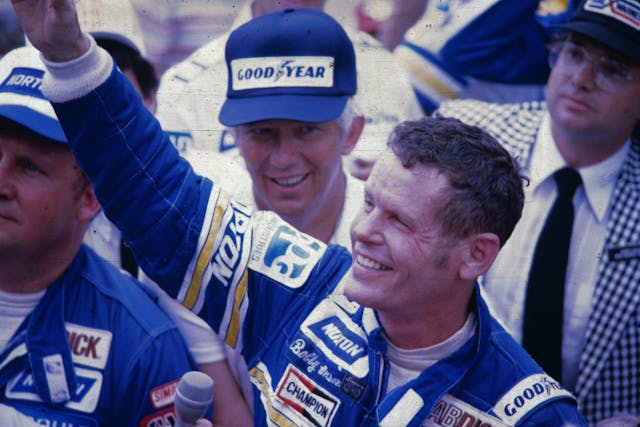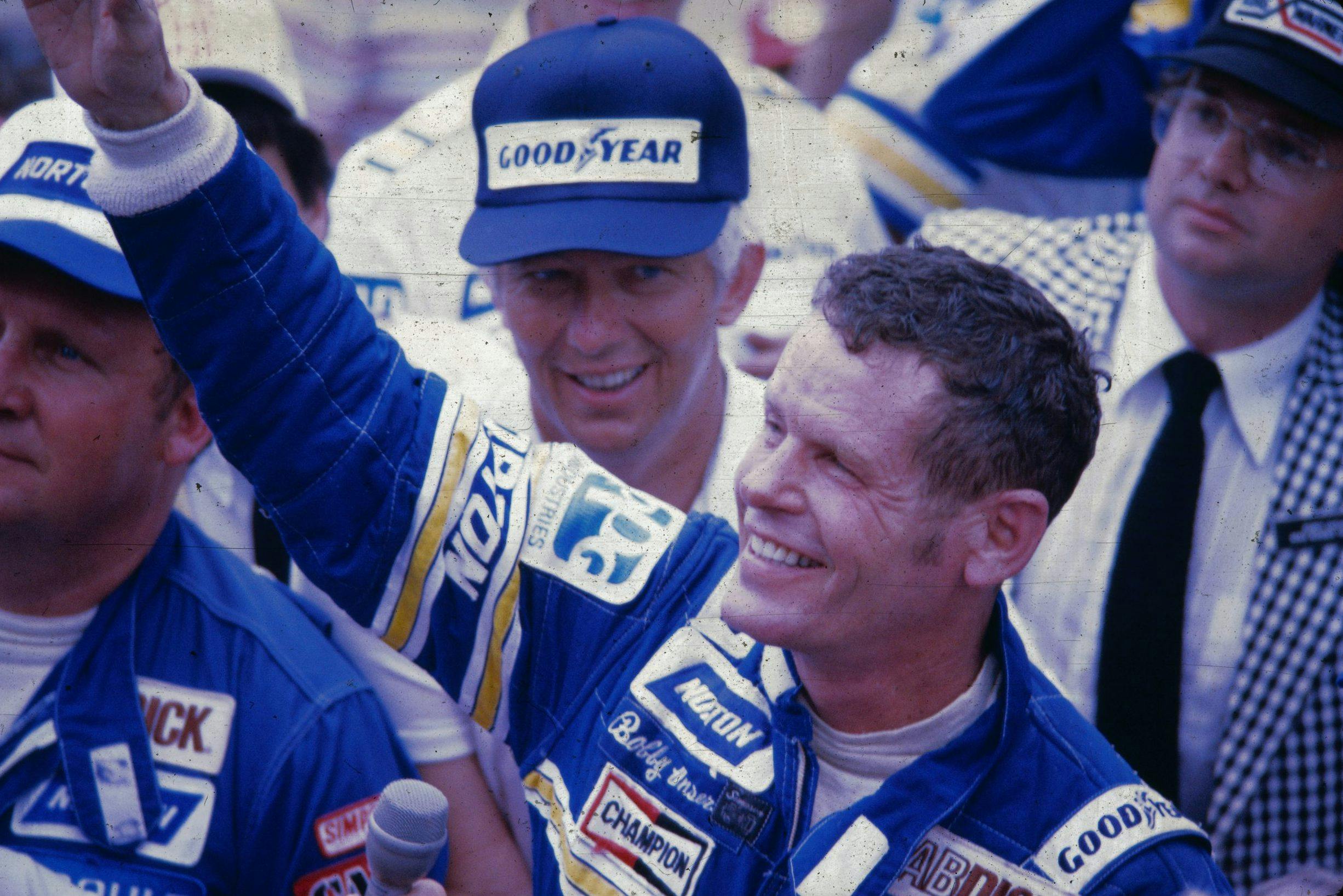Media | Articles
‘If they said something couldn’t be done, Bobby Unser wanted to do it’: The man remembered by friends, competitors
Most of the obits for racing legend Bobby Unser led with the gaudy statistics, and rightfully so: One Indianapolis 500 victory in each of three decades. Thirty-five Indy car wins and two national championships. A record 10 overall titles at Pikes Peak, earning him the sobriquet “King of the Mountain.” But numbers alone tell you nothing about the man himself, charismatic and opinionated, garrulous and gregarious, a captivating storyteller whose distinctive nasal twang and eye for telling detail made him a natural in the television broadcast booth after he left the cockpit.
“He was a colorful dude, and nothing was off the table with him,” says Mario Andretti, who was his close friend early on, then later his bitter rival. “He was fun to be around, and everything with him was an adventure.” Andretti chuckles as he thinks back for a story he can tell on the record. “Like the time we were in Italy to race at Monza. We didn’t have credentials for some reason. At the front gate, they wouldn’t let us in. So I just booked through, and when one of the carabinieri raised his gun, Bobby yells at me, ‘Wop! Go, go, go! He’s gonna shoot us!’”
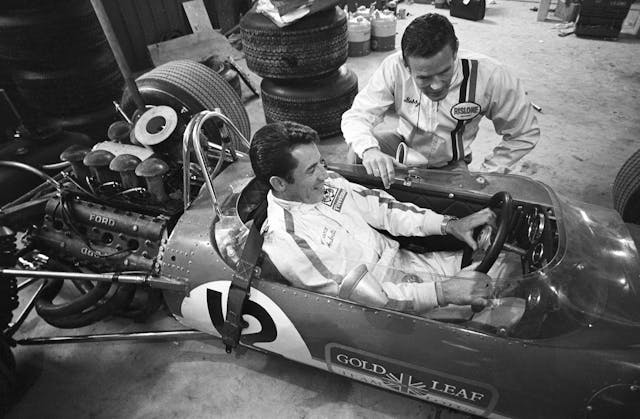
Unser was Indy car royalty, and he could command a room with his formidable personality. But he was also a fan favorite who always made time to sign autographs and share note-perfect anecdotes. The media appreciated him, too, because he was so accessible and honest. In an age when celebrities are shrouded behind elaborate public-relations machines and curated social media feeds, he listed his phone number and email address on his website, and he was happy to talk to anybody about anything. “Attention’s what you need to be popular. You need the ink,” he once told me, implying that he’d made a conscious decision to court the press. But I never bought it. I just think there was no filter between what he believed and what he said.
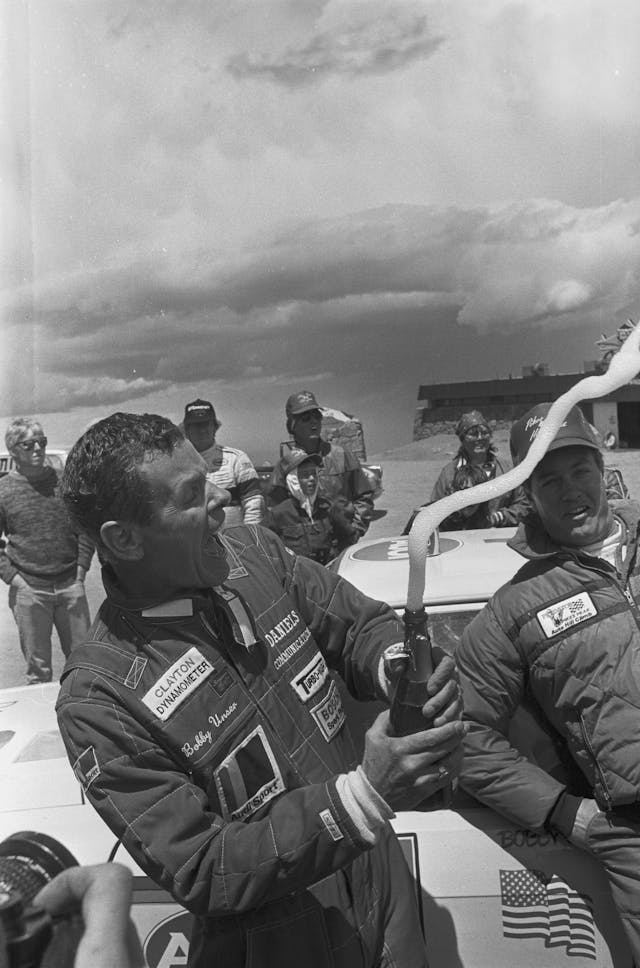
I first met Unser a few years after he’d briefly unretired from racing in 1986 to successfully smash the Pikes Peak mark that had been set the year before by rally heroine Michèle Mouton in an Audi Quattro. (“I’m not knocking the French people,” he said at the time, “but I just couldn’t see a French girl having the Pikes Peak record.”) With his piercing blue eyes, bronzed skin, and cocky smile, he still looked like a gunfighter who’d just breezed into town, leaving the locals wondering if he was there to cause mayhem or restore order.
At the time, I was writing a story about the 1958 U.S. Sports Car Grand Prix at Riverside, the first big-time professional road race staged in the United States. Unser had picked up a ride from hot-rodder Ak Miller, another Pikes Peak veteran, in a Devin-bodied junkyard dog powered by a stroked Chevy V-8. “It was faster than hell,” Unser told me.
Marketplace
Buy and sell classics with confidence
“Bobby,” I pointed out, “you qualified 12th. You were nearly 10 seconds slower than Chuck Daigh, who was on pole in the Scarab, and Phil Hill in a Ferrari.”
“If it’d had a limited-slip and a little more brake, I could have beaten the Scarab and the Ferrari,” he insisted. “If you can win at Pikes Peak, you can win anywhere.”
At the time, I thought he was delusional. But looking back, I realize that this was the sort of unshakable self-confidence needed to thrive during the most murderous era in American racing. In those days, the prospect of dying in a race car was a fact of life rather than a theoretical proposition. Unser’s uncle Joe had been killed while testing a car on a highway in 1929 in preparation for the Indy 500. His older brother Jerry survived a crash that vaulted him over the wall during the Indy 500 in 1958, only to perish from injuries suffered in a fiery practice wreck the following year.
Unser himself steered blindly through the flaming wreckage of the hellish crash that killed Eddie Sachs and Dave MacDonald at Indy in 1964. (During the red-flag stoppage, he prowled around Gasoline Alley, hoping to relieve another driver who didn’t have the stomach to climb back into his car.) And among the many racing mementoes he’d amassed over the years was a pretzeled steering wheel from an Indy car that he drove under a guardrail at Phoenix, barely escaping with his head attached to his body.
Even his practical jokes had a macabre tinge. While flying—he was a high-time private pilot—he would sometimes feather a prop to terrify passengers into thinking an engine had died, and while giving thrill rides up Pikes Peak, he would occasionally swerve onto a blind cutoff that seemed to lead straight off the mountain. In Albuquerque, where he lived in a compound—dubbed Unserville—not far from the gas station his father had run on Route 66, he told friends they could run red lights because the Unsers were tight with the cops. But when they approached a green light, he would suddenly shout, “Stop! Stop! Stop!” And as the driver slammed on the brakes, he would explain: “Al might be coming the other way.”
Unser began his career in jalopies and front-engine roadsters that placed a premium on brawn and bravery, and he ended it in ground-effects formula cars that rewarded an esoteric understanding of aerodynamics. Along the way, he competed in everything from sprint cars and midgets to La Carrera Panamericana and Formula 1, with detours to win an International Race of Champions title and set a land-speed record at Bonneville.
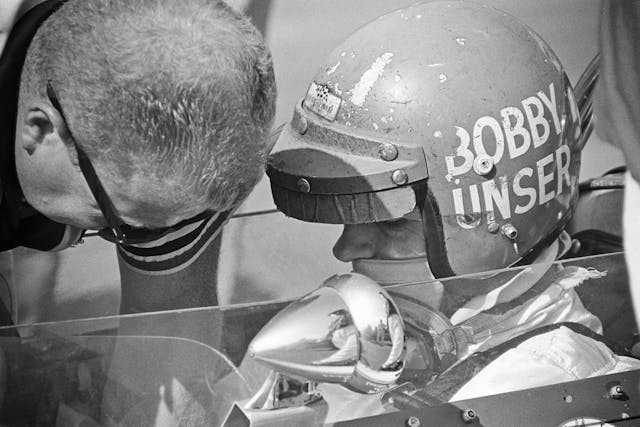
Of course, he was born to race; the Unser clan is as synonymous with the sport as the Andrettis or the Pettys. His uncle Louis was the King of the Mountain at Pikes Peak until Unser supplanted him. His younger brother, Al, won Indy four times, and Al’s son, Al Junior, earned two more Borg-Warner trophies. Unser’s son Robby also raced at Indy, as did his nephew Johnny. But even though racing was imprinted on his genetic code, Unser’s path to the top of the sport was filled with plenty of switchbacks and dead ends.
Despite several wins at Pikes Peak, he spent most of the 1950s eking out a paltry living on the racing equivalent of the “chitlin circuit” that supported Black blues and soul musicians in the South. He didn’t reach the big time until Parnelli Jones, the fearless and uncompromising winner of the 1963 Indy 500, took him under his wing. “He was my kind of guy,” Jones says. “He was a real racer and a hard charger. He was very fast, very aggressive, never stroking it out there on the track. He went through nine lives getting to where he got, but he still won a lot of races—a driver’s driver. He had the will to win, and he worked at it from the get-go.”
Jones remembers testing Unser in a midget he owned. They spent hours pounding around a dusty oval, with Unser chipping away at his lap times, but at the end of the day, he was still two-tenths off the track record. Finally, Jones told him to pack it in before Unser killed himself. Later, they discovered, they’d gotten some bad intel. Instead of being two-tenths slower than the record, Unser had actually broken it by nearly a second.
Speed was never an issue. It’s no coincidence that Unser tallied 49 Indy car poles against 35 race wins. (Al’s record was 28 poles and 39 wins.) “Watching the film of him at Pikes Peak is breathtaking. That’s obviously where he learned his car control,” says Robin Miller, the dean of IndyCar journalists. “But he wanted to lead every lap. If he was a straightaway ahead, he wanted to be a lap ahead. That probably cost him 15 wins right there.”
Unser scuffled on the fringe of IndyCar success before signing with Bob Wilke’s venerable Leader Card team in 1967, and the next year, he scored a popular win at the Speedway in an Offy-powered Eagle that inspired the hero car in the Paul Newman movie Winning. This led indirectly to a long relationship with Dan Gurney and All American Racers, which put Unser in the vanguard of the aerodynamics revolution.
Unser was the driver in the cockpit when the Gurney flap was invented and deployed during a preseason test at Phoenix in 1972. Three months later, in the Eagle he’d helped Gurney develop, Unser qualified on the pole at Indy at 195.940 miles per hour—three mph quicker than the second-fastest car and a mind-boggling 17 mph faster than the previous year’s pole-sitter. “I could have lapped the field in that ’72 Eagle while picking my teeth,” he said later. Alas, the car broke while leading. Another DNF followed in 1973. Then came a second-place finish in 1974. It wasn’t until 1975 that the Eagle finally soared to AAR’s first—and only—victory in the 500.
In 1979, Unser began the final phase of his career when Roger Penske hired him to serve as a wise, old head to complement a wunderkind named Rick Mears. As it happened, Unser had sung Mears’s praises when the younger driver was making the transition from off-road racing. But they were an odd couple at Penske, Mears sunny and carefree, Unser driven and methodical.
“I really admired his desire and competitiveness, on and off the track,” Mears says. “His philosophy was, ‘If I don’t have a five percent advantage, I’m 10 percent behind.’ Bobby didn’t want me to do a lot of testing, and he’d get upset when I’d show up.” He laughs and then says, raising the pitch of his voice to mimic Unser’s. “Tell him to stay home. I’m not testing cars to make Rick Mears go fast.”
Unser was so determined to find an edge that he fashioned a makeshift wind tunnel in his garage in Albuquerque, and he was instrumental in transforming the flat-bottom Penske PC6 into the ground-effects PC7. Unser went with the new chassis at Indianapolis in 1979 while Mears chose to stick with the old one. Unser was leading late when he lost top gear, and Mears inherited the win.
It wasn’t until 1981 that Unser found his way back to Victory Lane at Indy, and there’s a famous image of him there, grinning wildly and holding up three fingers. But you can’t find a traditional morning-after photo of Unser with his car and crew astride the row of bricks at the start-finish line. Thanks largely to ex post facto observations made by color commentator Jackie Stewart on ABC-TV’s tape-delayed broadcast, Unser was penalized for passing eight cars during a caution period, and Andretti was awarded the victory.
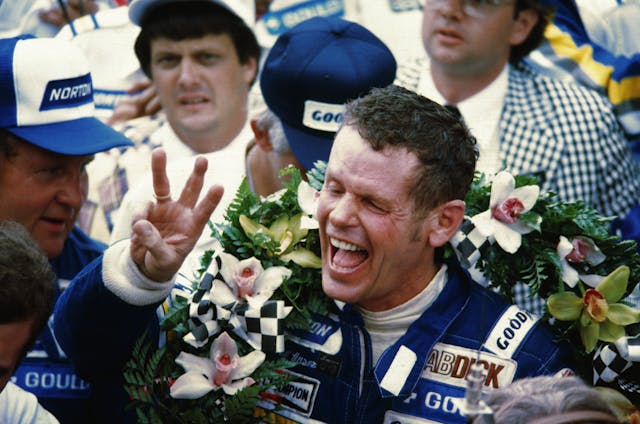
After 138 days of acrimonious legal wrangling, Unser was reinstated as the winner. “I had the best car, no question about it,” he told me when I was writing a story about the race. “But then we had to go through that kangaroo court, and it looked like Mario was going to be the recipient of something he didn’t earn. He didn’t outrun me. Passing him was frigging easy. I did it plenty of times, and he knew it.” Three decades after the fact, Unser was still aggrieved that Penske had refused to sue the people who’d tried to steal the race away from him.
Although he and Andretti eventually reconciled, the affair left a bad taste in Unser’s mouth, and he never raced seriously again after the 1981 Indy car season—which he closed out, fittingly, with back-to-back pole positions. Eventually, he would forge a new career in TV broadcasting, a field uniquely suited to his talents. “He was the smoothest-talking sumbitch who ever came down the pike,” says Edwin Render, the law professor who chaired the appeals board that ruled in Unser’s favor in 1981. “He could talk the ears off a wooden Indian.”
Unser covered CART, USAC, IRL, and NASCAR for ABC, NBC and ESPN. But he’s most fondly remembered for his (mostly) good-natured back-and-forths with fellow commentator Sam Posey, who came from the more effete world of road-racing. On occasion, their contretemps were more entertaining than the Indy 500s they were broadcasting, and if they were on the air today, Unser’s signature riposte—“Sam, you’re wrong”—would have become a meme.
There were other adventures, too, starting with the glorious one-and-done Pikes Peak comeback in 1986. In 1994, he led every lap en route to winning all three races and $100,000 in prize money in the Fast Masters series, a made-for-TV mashup of no-longer-ready-for-prime-time drivers in Jaguar XJ220 supercars on a Mickey Mouse “roval” at Indianapolis Raceway Park. Two years later, he nearly died of exposure during a snowmobile trip that went awry in a blizzard, spending a night in a man-made snow cave and trekking 14 miles through deep snow to safety.
Unser was among the last of the larger-than-life breed of oval-track racers illustrious enough to be known by their first names alone—Bobby, Al, Mario, A.J., Parnelli, J.R., Gordy. He enjoyed a storybook rags-to-riches life, and the fact that he made it to 87 years of age seems little short of a miracle. “If something is easy, it’s not worth having, and if it’s easy to do, it’s not much of a thrill,” he once declared. “I like challenges. If somebody says something can’t be done, that’s where Bobby Unser wants to go.”
